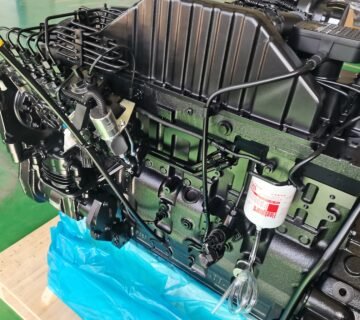How Cummins’ Low-Sulfur Diesel Engines Improve Air Quality
In an era where air quality and environmental sustainability dominate global agendas, Cummins Inc. has emerged as a leader in clean diesel innovation. By integrating low-sulfur diesel engines with advanced aftertreatment technologies, Cummins delivers solutions that drastically reduce harmful emissions while maintaining the power and reliability synonymous with its brand. This article explores how Cummins’ engineering advancements—from fuel system precision to exhaust scrubbing—are transforming diesel engines into allies for cleaner air.

The Science of Low-Sulfur Diesel: A Foundation for Cleaner Combustion
Traditional diesel fuel contains sulfur, which contributes to sulfur oxides (SOx) emissions linked to respiratory illnesses and acid rain. Cummins’ ultra-low sulfur diesel (ULSD) engines operate on fuel with 15 ppm (parts per million) sulfur content, a 97% reduction compared to legacy diesel. This shift, mandated by regulations like the U.S. EPA’s Tier 4 standards and Euro VI, enables two critical benefits:
- Reduced SOx Emissions: Lower sulfur fuel minimizes sulfur dioxide (SO₂) and sulfate particulate formation.
- Optimized Aftertreatment Efficiency: ULSD prevents sulfur poisoning of catalysts in Selective Catalytic Reduction (SCR) systems, ensuring long-term NOx reduction.
Cummins’ X15 Efficiency Series and B6.7 engines exemplify this synergy, achieving near-zero SOx emissions while maintaining fuel economy.
Advanced Aftertreatment: Turning Exhaust into Harmless Byproducts
Cummins’ low-sulfur diesel engines are paired with a multi-stage aftertreatment system designed to neutralize pollutants:
- Diesel Oxidation Catalyst (DOC)
The DOC converts carbon monoxide (CO) and hydrocarbons (HC) into carbon dioxide (CO₂) and water (H₂O). ULSD’s low sulfur content prevents sulfur deposits, maintaining DOC efficiency over 300,000+ miles.
- Diesel Particulate Filter (DPF)
Cummins’ DPF technology captures 99% of particulate matter (PM), including black carbon—a major contributor to smog. ULSD reduces ash accumulation in DPFs, extending service intervals by 30%.
- Selective Catalytic Reduction (SCR)
Using Diesel Exhaust Fluid (DEF), SCR systems break NOx into nitrogen and water. Low-sulfur diesel ensures DEF injectors and catalysts remain unclogged, sustaining 95%+ NOx conversion rates.
Real-World Impact: Case Studies in Air Quality Improvement
Cummins’ technologies are validated across industries:
– Public Transit: Los Angeles Metro’s switch to Cummins L9 diesel engines with ULSD and SCR reduced fleet NOx emissions by 89% and PM by 98%, meeting California’s CARB 2023 mandates.
– Port Operations: The Port of Long Beach reported a 70% drop in SOx levels after adopting Cummins QSK95 engines in cargo-handling equipment.
– Agriculture: A 2023 study in Iowa showed Cummins QSX15 engines in tractors reduced on-farm PM emissions by 85%, improving local air quality.
Fuel System Innovations: Precision Meets Efficiency
Cummins’ high-pressure common rail (HPCR) fuel systems are engineered for ULSD compatibility. Key features include:
– 2,600 Bar Injection Pressure: Ensures finer fuel atomization, reducing unburned hydrocarbons and soot.
– Adaptive Control Modules: Adjust injection timing based on fuel sulfur content detected via onboard sensors.
– XPI Ultra-High-Pressure Injectors: Minimize deposit formation, even with biodiesel blends up to B20.
These innovations enable engines like the X12 to achieve 5% better fuel efficiency than previous models while slashing CO₂ emissions.
Biodiesel Synergy: Enhancing Sustainability
Cummins’ low-sulfur diesel engines are compatible with B20 biodiesel blends, amplifying air quality benefits:
– Lower Carbon Footprint: B20 reduces lifecycle greenhouse gas emissions by 15% versus pure diesel.
– Improved Lubricity: Biodiesel compensates for ULSD’s lower lubricity, protecting fuel pumps and injectors.
In Chicago, a fleet of Cummins-powered school buses using B20 reported a 20% reduction in PM emissions and $12,000 annual fuel savings.
Overcoming Challenges: Cold Starts and Fuel Stability
While ULSD improves air quality, it poses operational challenges:
– Cold-Weather Performance: ULSD has a higher cloud point. Cummins addresses this with heated fuel filters and winter-grade additives in engines like the ISX12N.
– Fuel Degradation: ULSD is prone to microbial growth. Cummins’ FuelGuard™ Stabilizer extends storage life by inhibiting bacteria.
The Road Ahead: Cummins’ Vision for Cleaner Air
Cummins is pushing boundaries with:
– Digital Twin Technology: Simulating combustion dynamics to optimize ULSD use in diverse climates.
– Solid SCR Catalysts: Developing sulfur-resistant catalysts to tolerate higher biodiesel blends.
– Carbon Capture Pilots: Partnering with LanzaTech to test onboard CO₂ capture systems for maritime engines.

Conclusion: Clean Diesel as a Catalyst for Healthier Communities
Cummins’ low-sulfur diesel engines prove that diesel technology can coexist with environmental stewardship. By combining ULSD compatibility, precision aftertreatment, and renewable fuel readiness, Cummins reduces emissions of NOx, PM, and SOx—directly improving air quality in urban, industrial, and rural settings.
For businesses navigating stricter emissions regulations, Cummins offers a pragmatic path to compliance without sacrificing performance. As the world transitions to zero-emissions solutions, Cummins’ clean diesel engines remain a vital bridge—demonstrating that sustainability and power can, indeed, go hand in hand.





No comment